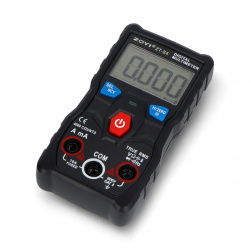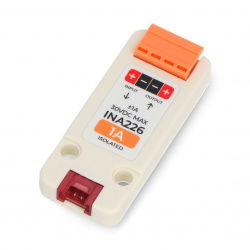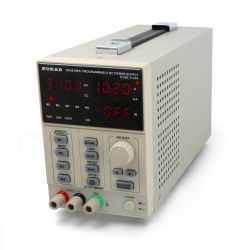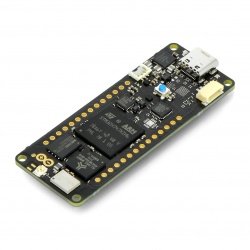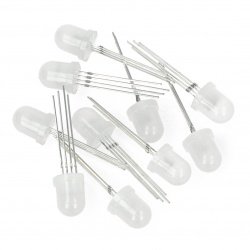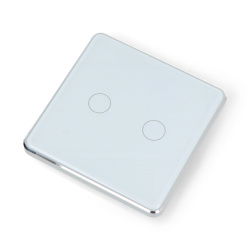Touch button, also known as the sensor, allows you to control different devices through response to touch, individuals. Due to the lack of mechanical moving parts, differs high reliability and durability unlike the ordinary electric buttons. Finds application, in particular, tablets and smartphones. Every physical touch to the touch sensor through the user's fingers or a special stylus that is registered through the entry system of the processor, and then handled in accordance with the instructions given in the firmware, depending on the applied pressure, hold time, and the direction and length of the path traveled on the screen using the user's finger or stylus.
Touch buttons
CAP1188 I2C/SPI touch module - 8 buttons - Adafruit 1602
The module with the CAP1188 system that implements 8 of the capacitive touch buttons. Pins can be connected to any of the objects conducting the electric current. The board...12-Key Capacitive Touch Sensor Breakout - MPR121
The module with the MPR121 system that implements 12 of the capacitive touch buttons. Pins can be connected to any of the objects conducting the electric current. The board...Sonoff T3EU1C-TX - wall touch switch - 433MHz / WiFi - 1-channel
Intelligent surface-mounted switch Sonoff T3 from the TX series. It is equipped with 1 channel , so you can control 1 power circuit. It allows you to control the lighting by...DFRobot Capacitive Touch Kit - a touch kit for Arduino
A kit for self-assembly of the capacitive touch for Arduino. The set consists of three styles of touch sensors: round in the style of iPod; touch keyboard that supports...Velleman VMA305 - module with capacitive button
Module with touch, capacitive button which requires a little pressure to activate. The output is the analog signal.Touch button AT42QT1010 - SparkFun module SEN-12041
A module made by SparkFun with a capacitive touch button based on AT42QT1010 system. It is powered with the voltage in the range from 1.8 V to 5 V. It has a digital output...TTP224 4-way Capacitive Touch Switch Module
Capacitive touch sensor based on the TTP224 module. It is powered by a voltage from 2.4 V to 5.5 V, the output is a digital signal. It has 4 buttons with LED signaling.Tuya LS3 - touch wall switch - ZigBee - 3-channels
Three-channel wall switch, touch. It allows you to control three light circuits. For proper operation of the switch you only need to connect a phase wire. The switch for...DFRobot Gravity - capacitive touch sensor
Capacitive touch sensor uses a digital interface to work. It can be powered with the voltage from 3.3 V to 5 V. It feels the human or metak touch, even through a fabric or paper.Makey Makey - version Classic - by JoyLabz - SparkFun KIT-14478
This kit consists of USB board and cables, allows you to create keyboard of any items, such as chagning the stairs into piano or making the gamepad from the fruits. The device...Sonoff T3EU3C-TX - wall touch switch - 433MHz / WiFi - 3-channel
Sonoff T3EU3C-TX - the smart touch switch. It is equipped with 3 touch buttons so you can control three light circuits. The control is also done with the use of applications...Tuya ZLS2S - touch wall switch - ZigBee - 2-channels
A wall contact switch to control two light circuits. The switch requires only a phase wire. It communicates through the ZigBee protocol version 3 .0, according to the...MPR121 I2C touch module - 12 buttons - Adafruit 1982
The module with the MPR121 system that implements 12 of the capacitive touch buttons. Pins can be connected to any of the objects conducting the electric current. The board...See also
What are the most popular types of touch sensors and how do they work?
Among the two most popular touch button technologies, a distinction is made between capacitive and resistive buttons . Capacitive buttons operate on the principle of detecting the presence of materials with dielectric permittivity significantly different from air, and such properties are represented by, among others, human body including fingers. Maneuvering your fingers on the glass surface of the capacitive buttons causes local changes in the intensity of the electrostatic field on this surface and changes in the electrical capacity between the touch fields, which are constantly monitored by the microprocessor in order to correctly recognize the coordinates where the changes in electrical capacity occurred. Most touch displays are based on this technology, including: tablets, industrial control panels and phones. Another touch sensor technology is resistive buttons, which use a glass and plastic surface coated with indocin oxide on a layer opposite the touch layer. The glass layer is also coated with indocin oxide. When a finger or stylus presses on a plastic surface, this surface comes into contact with the glass surface and the measurement system measures the resistance between these surfaces, providing touch data to the microprocessor in the same way as in the case of capacitive sensors.
Touch button modules for embedded systems
You can use the touch button in various projects involving manual control of devices. The multi-channel button modules offered by the Botland store are compatible with Arduino, thanks to the ability to communicate via I2C and SPI buses. Thanks to such sensors, you can design an interface controlling roller blinds and other building automation elements, build a pocket-sized music synthesizer, and even construct simple games to train reflexes for two people. Our offer also includes specialized integrated circuits that work with touch buttons.
Touch and capacitive buttons - FAQ
Tece flush buttons are compatible with models from the same series. Before choosing a button, it is worth consulting the seller or reading the technical specifications of the product.
Buttons for Geberit sets fit models from the same series. Before purchasing, it is best to consult the seller or read the technical specifications.






























































































































































































































































































































